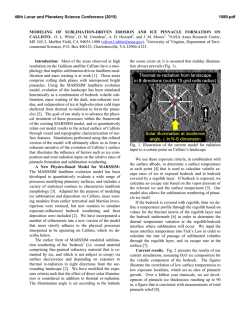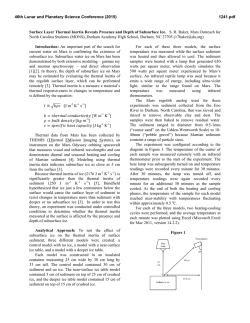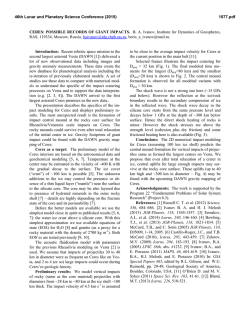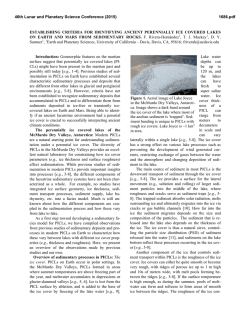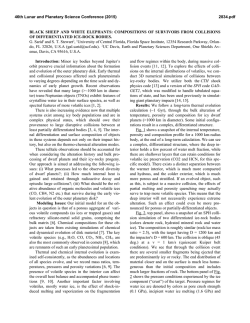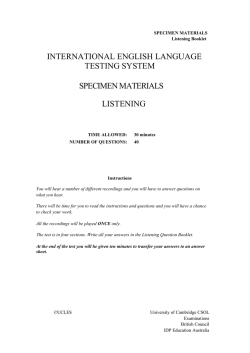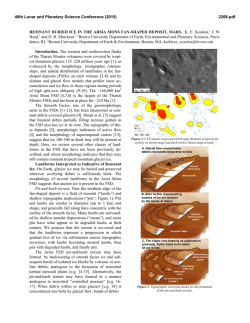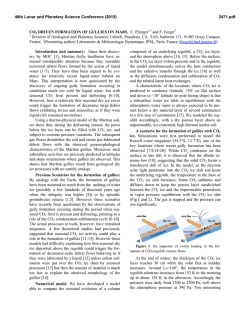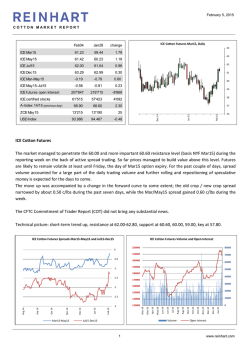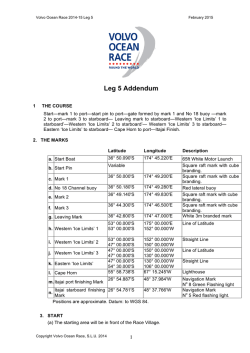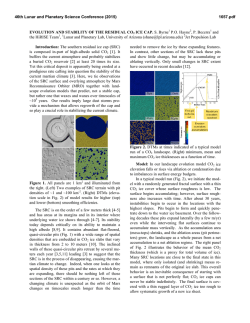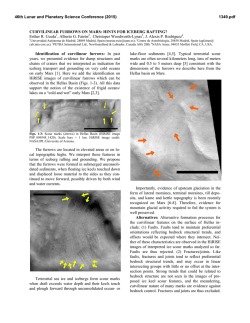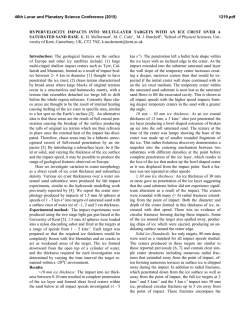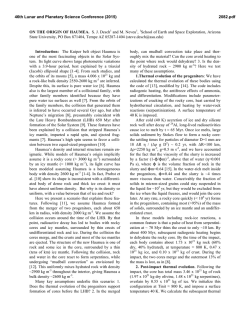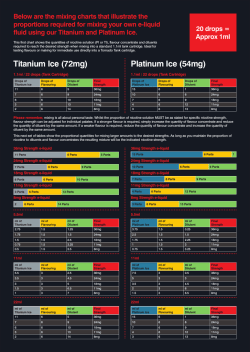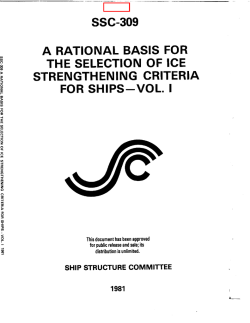
SORTING OF A DIFFERENT SORT: EXPERIMENTAL
46th Lunar and Planetary Science Conference (2015) 1020.pdf SORTING OF A DIFFERENT SORT: EXPERIMENTAL OBSERSERVATION OF SUBLIMATIONDRIVEN GRAIN SIZE SORTING IN MARS-ANALOG EXCESS ICE SIMULANTS. J. S. Levy1, L. M. Schmidt1, and D. S. Aylward1, 1Univeristy of Texas Institute for Geophysics, 10100 Burnet Rd., Austin, TX, 78758, USA. [email protected]. Introduction: Sublimation of water ice is one of the most common physical processes to occur on planetary surfaces, and yet because sublimation is a relatively uncommon geological process on Earth, the dynamic processes controlling landscapes shaped by sublimation remain largely unknown (1). This makes it impossible to use the topography, geomorphology, and sediment distribution of sublimation-driven landscapes to quantitatively determine the amount of ice in a planet’s subsurface and how the surface has evolved. Ground ice is currently stable on Mars polewards of ~60˚ latitude (2,3) and is widespread in both hemispheres (3). Water ice emplaced on Mars during recent high-obliquity “ice ages” may still be present at middle latitudes (~30-60˚), protected by an insulating sedimentary lag deposit (4-7). Over geological time, this ice will return, via sublimation, to the poles (8,9). Two fundamental questions remain about the nature and origin of martian ground ice: 1) How is ice distributed in martian permafrost: is martian ground ice present mostly in a massive, draped “latitude dependent mantle” (LDM), or is most martian ground ice present in the pore space between regolith sediment grains? 2) What is the thermal history of martian permafrost: has melting been a major geomorphic agent shaping martian permafrost (10-13), or has martian permafrost remained largely cold and dry, in equilibrium with current climate conditions (14-17)? To address these questions, we used a laboratory simulator to quantitatively measure how sublimation of water ice shapes planetary surfaces through grain size sorting during sublimation of buried ice (18). Sorting is the preferential redistribution of grains of a particular size to different positions in the soil column (vertical sorting) or to different lateral locations at the surface (horizontal sorting). Unlike terrestrial environments, in which freeze-thaw cycling drives grain size sorting and changes to active layer topography (19), in our simulations, sublimation is the only phase change driving surface change. Methods: We constructed a simple apparatus for experimentally driving surface change (sediment sorting and changes to surface topography). The apparatus consists of a 1.0 x 0.5 m rectangular acrylic tank, separated into three rectangular chambers: two ~5 cm deep chambers on either side of a central ~30 cm deep chamber. The outer two chambers provide insulation for the inner chamber, minimizing horizontal heat flow. The experiments described here measure the change in grain size distribution and changes to surface topography for a soil column simulant composed of dry ice (to ensure that sublimation is the only ice phase change) and JSC Mars-1A. In all experiments, 1-3 slabs (5 cm thick) of dry ice were placed in the base of the tank and were covered with JSC Mars-1A sediment to a depth of 2-3 cm. This simulates slab ice conditions observed at the Phoenix landing site (20). Three classes of experiments were conducted to measure the evolution of sorting and surface topography. To measure the development of vertical sorting, sediments were placed directly over the ice blocks and a “before” sample was taken from the homogenous soil column. The ice was allowed to sublimate completely, and then sediment samples were taken from the upper and lower 1 cm of the soil column. To measure horizontal sorting, the simulation tank was tilted to a ~25˚ slope and filled with ice blocks that were subsequently covered in ~1 cm of sediment. “Before” samples were taken from the upslope (upper 10 cm) and downslope (lower 10 cm) of the surface. The ice was allowed to sublimate completely, and then sediment samples were collected from the same regions that the initial samples were collected. Finally, to measure topographic change, ice blocks were loaded into the tank with a ~1 cm gap between blocks. The ice was covered in sediment and sediment was allowed to infill the gap (producing a wedge of sand). Ice surface height was measured via time lapse imaging and via stereo photogrammetry as the ice sublimated. Results: Preliminary experimental results (Figs. 13) show that vertical and horizontal sorting of coarse and fine sediments can be generated via sublimation. Results are reported in terms of sorting index, where SI is mass percent at a given grain size in the final sample divided by mass percent at a given grain size in the original state. SI > 1 indicates enrichment at a given grain size, while SI < 1 indicates depletion. Conclusions: These preliminary results suggest that grain size sorting behavior typically thought to only occur under freeze-thaw cycling can be generated by sublimation of excess ice underlying sediments. The experimental formation of these sedimentary structures suggests that sorted surfaces on Mars could have formed solely via sublimation and not via freezethaw cycling. This process may also act to shape the grain size distribution on other icy bodies, including polar ice deposits on the Moon and Mercury, as well as the sedimentary surfaces of comets. 46th Lunar and Planetary Science Conference (2015) Acknowledgements: This work was supported by a Jackson School of Geosciences Planetary Seed Grant program award to JSL. References: [1] Mangold, N. (2011) Geomorphology, 126, 1–17. [2] Mellon, M. T. & Jakosky, B. M. (1993) JGR, 98, 3345–3364. [3] Boynton, W. V. et al. (2002) Science, 297, 81–85. [4] Head, J. W. et al. (2003) Nature, 426, 797–802. [5] Milliken, R. E. et al. (2003) JGR, 108, doi:10.1029/2002JE002005. [6] Mustard, J. F. et al (2001) Nature, 412, 411–414. [7] Kuzmin, R. O. (2005) Water on Mars and Life, Springer, 155–189. [8] Schorghofer, N. (2007) Nature, 449, 192–194. [9] Schorghofer, N. & Aharonson, O. (2005) JGR, 110, doi:10.1029–2004JE002350. [10] Page, D. P. (2007) Icarus, 189, 83-117. [11] Soare, R. J. et al. (2008) EPSL, 272, 382-393. [12] Balme, M. R. et al. (2009) Icarus, 200, 30-38. [13] Stoker, C. R. et al. (2010) JGR, 115, doi: doi:10.1029/2009JE003421. [14] Schorghofer, N. & Forget, F. (2012) Icarus, 220, 1112–1120. [15] Kreslavsky, M. A. et al. (2008) PSS, 56, 289–302. [16] Orloff, T. et al. (2011) JGR, 116, doi: doi:10.1029/2011JE003811. [17] Levy, J. S. et al. (2010) Icarus, 206, 229–252. [18] Levy, J. S. et al. (2010) Icarus, 209, 390–404. [19] French, H. (2007) The Periglacial Environment, Wiley. [20] Smith, P. H. et al. Science, 325, 58–61 (2009). 1020.pdf Fig. 1. Results of sublimation-driven vertical sorting experiment 081114-1. Coarse grains have been concentrated in the upper cm of the soil column, while fine grains have been concentrated in the lower cm of the soil column. Fig. 2. Results of sublimation-driven horizontal sorting experiments. Coarse grains have been preferentially sorted downslope, while fine grain sizes are enriched in the upslope portion of the soil surface. Fig. 3 (At Left) Time-lapse imaging of sediment sorting during sublimation experiments. Note that during sublimation, the topography of the surface can invert [e.g., 18] as thick sedimentary deposits slow the sublimation of underlying ice.
© Copyright 2026

